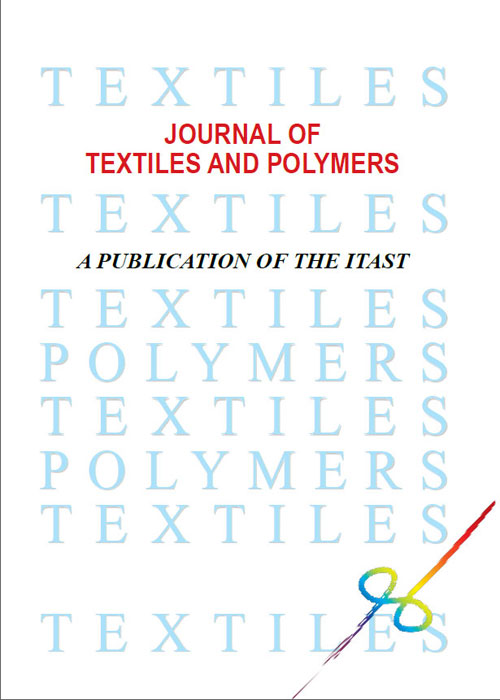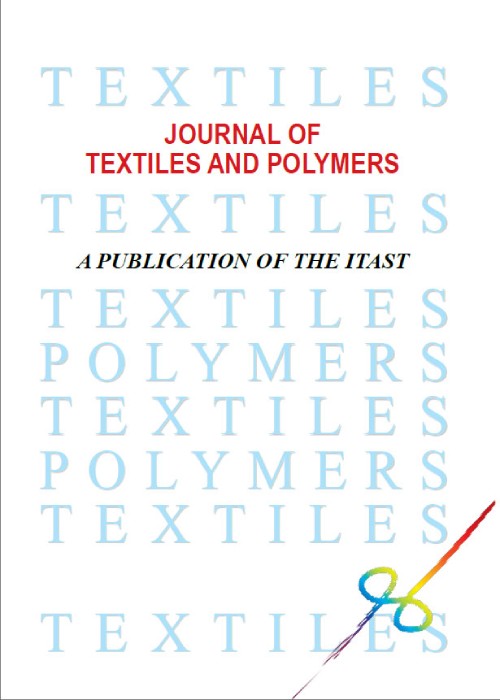فهرست مطالب

Journal of Textiles and Polymers
Volume:4 Issue: 1, Winter 2016
- تاریخ انتشار: 1394/11/30
- تعداد عناوین: 7
-
-
Pages 1-8Knitted fabrics are widely used by the underwear apparel industry due to their good elasticity. Modeling the mechanical behavior of knitted fabrics using Kelvin model is one of the discussed subjects in the textile industry. The purpose of this study is to investigate the accuracy of a nonlinear Kelvin model for determining the drying behavior of knitted fabrics. To fulfill this aim, genetic algorithm was used to optimize the model to achieve the lowest error between experimental and model results. The Kelvin model consists of a concentrated mass, a spring and a damper which are arranged in parallel. In the model a timevarying mass was considered due to the fabric drying process. Also, the behavior of the spring and damper were considered to be two-order nonlinear. Because of the nonlinear behavior of the spring and damper, the determination of the spring and damper coefficients by numerical methods was complicated. These coefficients were determined by minimizing the errors between the model and experimental results using the genetic algorithm. The results of the modeling of the knitted fabrics were compared to the experimental data for five samples with different course densities. The meaningful 4.5 percent difference between the purposed model and the experimental values proved that the presented system had acceptable results which could be used to investigate the length changes of knitted fabrics during drying processes. So, it was confirmed that the drying behavior of the knitted fabrics can be simulated by the nonlinear Kelvin model.Keywords: drying behavior, Genetic Algorithm, model accuracy, non, linear Kelvin model, weft knitted fabric
-
Pages 9-14During recent years, the fabrics made from different yarns have been used for industrial purposes such as composite materials. Given the importance of the shear properties of these fabrics, a mechanical model based on the Grosberg and Park's Model for hybrid plain-woven fabrics is proposed. In this model, using the Energy method, the initial load-shear angle behavior of hybrid fabrics is calculated from the yarn mechanical properties and the fabric structure. To evaluate the proposed model, the experimental results for initial shear modulus obtained from pure and hybrid fabrics of basalt and nylon are compared with the theoretical model results. A comparison of the results shows that there is rather a good agreement between the proposed model predictions and experimental results.Keywords: energy method, Hybrid, initial modulus, shear behavior, woven fabric
-
Pages 15-19This study presents a method for fabrication of ultrafine polymeric nanofibers as well as nano/micro particles utilizing centrifugal and electrostatic forces simultaneously. To reduce the diameter and variety of nanofibers produced from solid state polymerized PA66, a unique electrocentrifuge spinning device was utilized with a rotating nozzle and collector, while the fabrication process (spinning head) was securely sealed from ambient airflow. An electric field was applied between the nozzle containing the polymer solution and the cylindrical collector. Due to centrifugal force, polymer solution was ejected from the nozzle tip and extended by the centrifugal force as well as the electrical force. The diameters of nanofibers were controlled by adjusting the solution concentration, the rotational speed of the spinning head, the syringes content and the applied voltage. Field emission scanning electron microscope (FESEM) results demonstrate that this air-sealed centrifuge electrospinning (ASCES) system has a unique ability to produce high quality ultrafine nanofibers from SSP PA66 polymer. The good control of parameters led to the production of fibers with mean diameter of 63 nm. It is also shown that this technique has a good ability to fabricate particles of poly (ε-caprolactone), like electrospray ionization.Keywords: air, sealed electro, centrifuge spinning, biodegradable particles, solid state polymerized polyamide, ultrafine nanofibers
-
Pages 20-26Glass fiber reinforced gypsum composites are new building materials that have been used in covering interior walls. Reinforcement by means of woven fabrics as a three dimensional material is an alternative to the use of short fibers. The application of appropriate fabrics can improve mechanical properties of gypsum composites. The aim of this research article is to investigate the effect of the application of mesh fabrics on mechanical properties of gypsum composites. To do so, three types of fabrics made of E-glass yarns with leno texture - to strengthen the warp and weft of the fabric in the gypsum mixture- were used. Bending, tensile and compression tests were carried out on them, and then statistical analyses were performed on the data. The results showed that the bearing capacity of compressive load in gypsum composites strongly depends on the joint between the layers of fabrics and mortar. The strength of the fabric plays an important role in the bending behavior of composites and the joint between the yarns of the fabric and mortar is the effective factor in the tensional load capacity.Keywords: Gypsum mortar, reinforcement, Mechanical properties, direction of warp, weft
-
Pages 27-36Thermal analysis of acrylonitrile/acrylic acid P(AN/AA) copolymer films containing 5%, 10% and 20% acrylic acid dendrigrafted with citric acid (CA) is examined using differential scanning calorimetry (DSC) with various heating rates, thermogravimetry (TGA) and derivative thermogravimetric analysis (DTG). Also, the effect of carboxylic acid on thermal stabilization of the P(AN/AA) copolymers, when the carboxylic acid groups are in the bulk and when they are on the surface of the films dendrigrafted with CA, were studied using FTIR analyses. It is demonstrated that inclusion of carboxylic acid considerably enhances the rate of thermal degradation. The apparent activation energy (Ea) for overall cyclization and oxidation reactions is calculated using Kissingers method. The results reveal that carboxylic acid, when used as a dendrigraft, influences the cyclization and oxidation process in a different way in comparison with when they are in the bulk. The activation energy of the first generation dendrigrafted P(AN/AA) copolymer was lower than that of the copolymer and the forth dendrigraft generation.Keywords: acrylonitrile, acrylic acid copolymer, activation energy, dendrigraft, stabilization, thermal analysis
-
Pages 37-44In this research, fire and radiant heat protection and thermal comfort properties of cotton/nylon-Kermel blended woven fabrics, were utilized to predict the thermal comfort and protection limit of this fabric structure based on Woo and Barker developed model. The results showed that the porosity, the air permeability and the thermal resistance increased with Kermel fiber blend ratio. Conversely, the water vapor resistance decreased with increase of Kermel fiber blend ratio up to 40%. The thermal conductivity of blended fabric didnt change with the increase in Kermel fiber blend ratio up to 40%. Cotton/nylon fabrics, particularly those containing 30% Kermel, exhibited the highest upper thermal comfort limit and also the widest range of fabric metabolic activity level. The Kermel fibers had a significant effect on prevention of fire diffusion and Radiant Protective Performance (RPP) of fabrics. The results of vertical wicking and MMT tests show that adding Kermel fibers up to 10% detracts these thermal comfort properties significantly. The results of this research suggest that blending Kermel fiber with cotton and nylon at a blend ratio of 30% enhances thermal comfort limit and heat protection of blended fabrics. Moreover, cotton/nylon (50/10) blended with 40% Kermel fiber leads to desirable thermal comfort properties.Keywords: kermel, thermal comfort limit, thermal conductivity, thermal resistance, radiant protective performance (RPP)
-
Pages 45-52Electrospinning of nanofibers with cyclodextrin (CD) is attractive because the produced fibers can potentially increase the efficiency of nanofibrous membranes by facilitating the complex formation with organic compounds and high surface area of the nanofibers. In this work, polyacrylonitrile (PAN) nanofibers functionalized with β cyclodextrin (βCD) during an electrospinning process were used to treat a reactive dye wastewater stream by dynamic method. It was found that the dye removal efficiency was increased from 15.5% for PAN to 24% for PAN/βCD nanofiber mats. The low efficiency of PAN/βCD membranes was due to the decrease in the βCD content during the filteration process because of the high solubility of βCD in aqueous solutions. By crosslinking βCD through a polycondensation process, the PAN nanofibrous membranes containing βCD polymer (βCDP) were prepared and used for filtration. Compared with PAN nanofibers, it was found that the dye removal efficiency improved more than two times by using PAN/βCDP nanofibers. In such circumstances, due to the decrease in the water solubility of βCDP, the βCDP content in nanofibers didnt change during filtration; therefore, the dye removal efficiency of the PAN/βCDP nanofibers was higher than that of the PAN/βCD ones. The XRD results also showed that inclusion complexes between the βCD cavities and dye molecules were formed.Keywords: ?–cyclodextrin, inclusion complex, nanofibrous membrane, Reactive Dye, Wastewater


